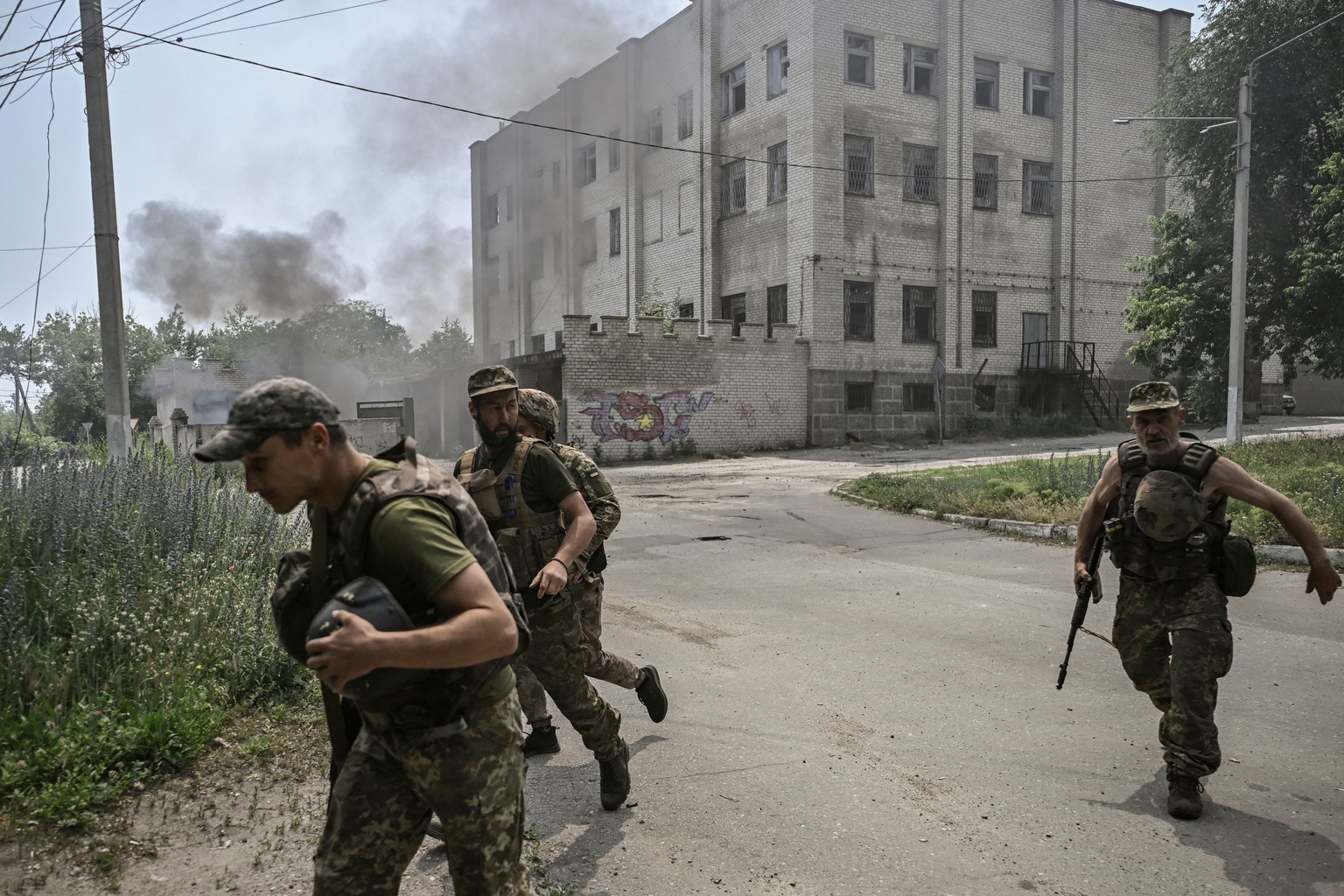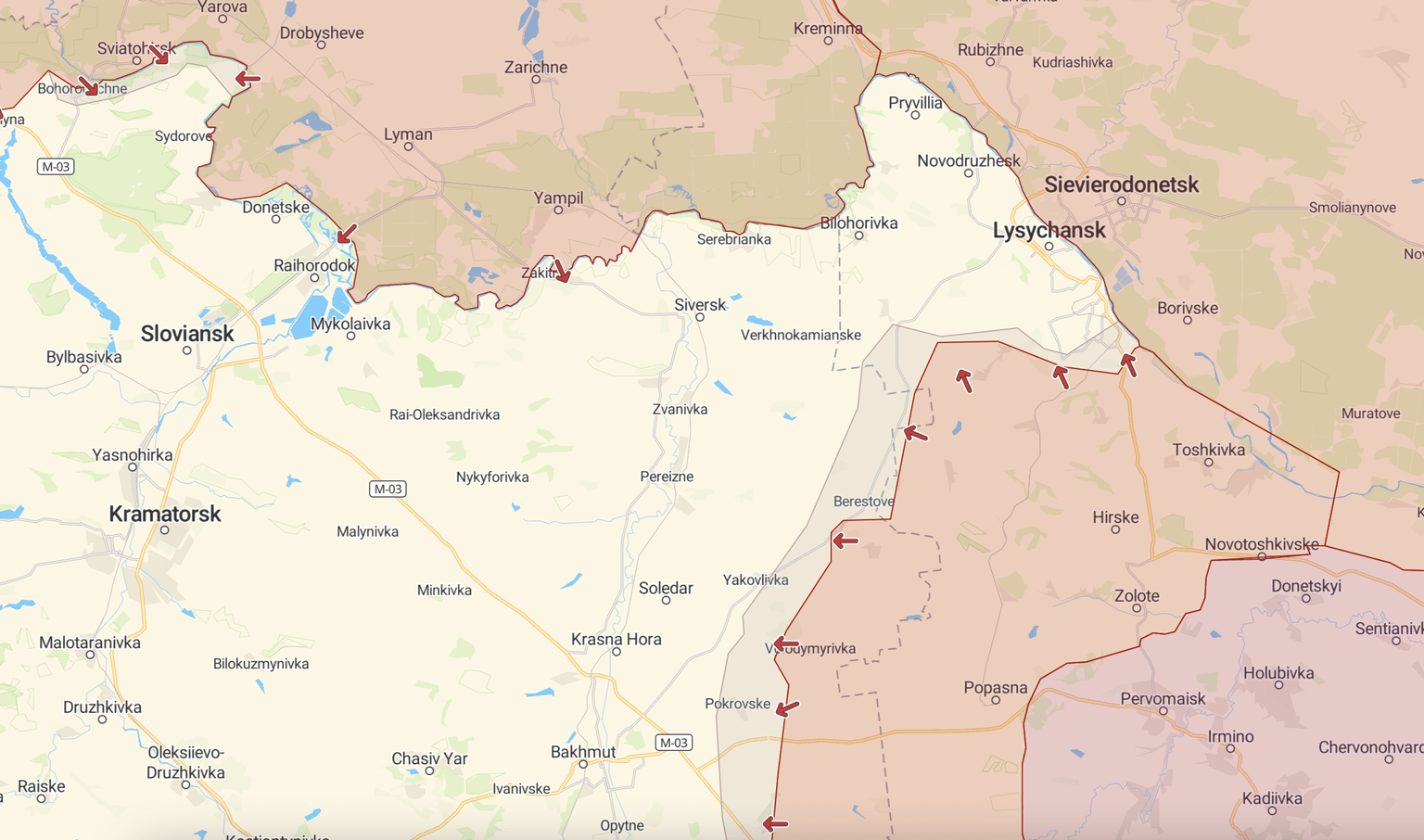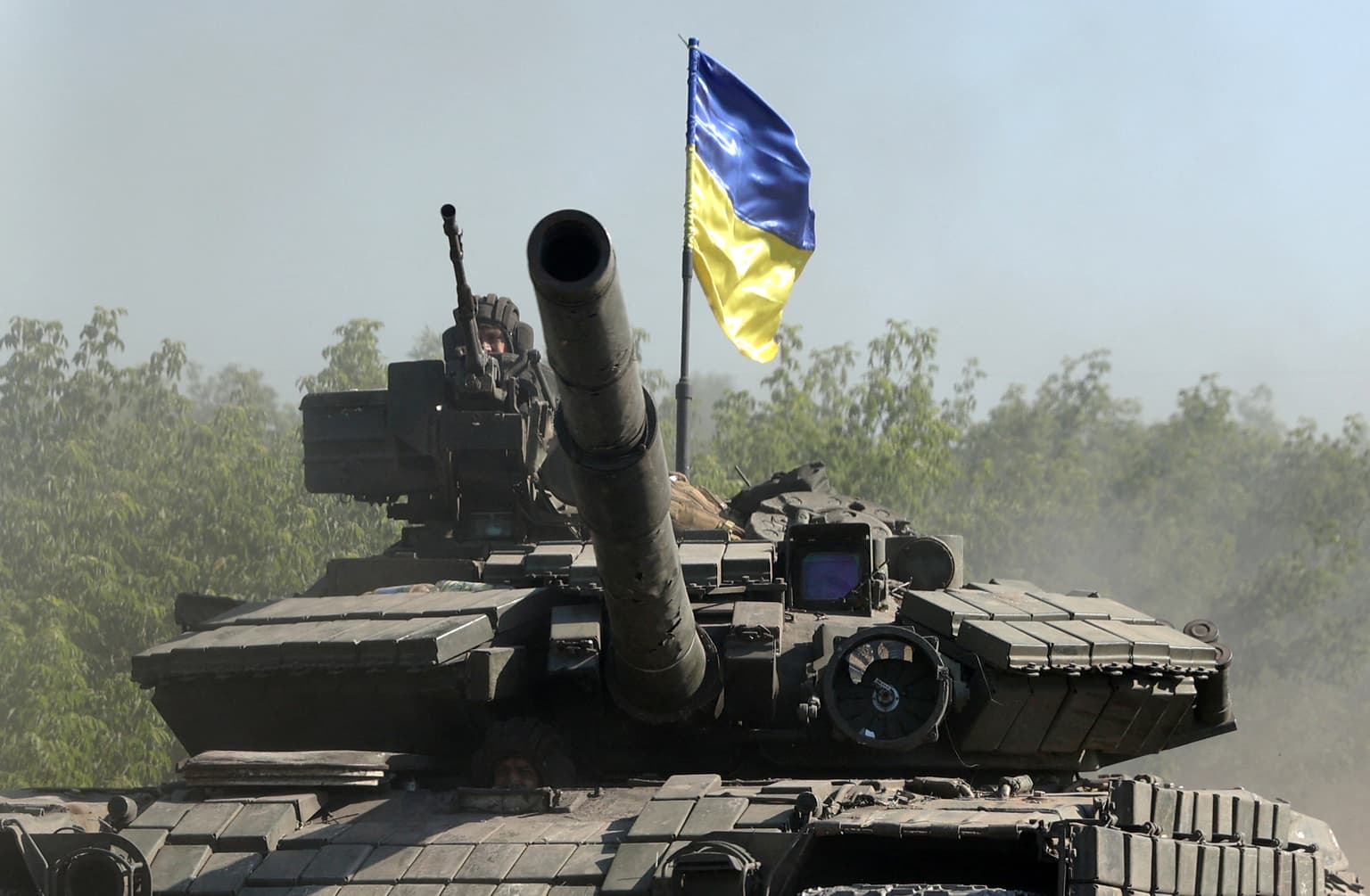In the Battle of Donbas, Ukraine’s military has made a painful yet long-anticipated decision — withdrawing from the last patches of the city of Sievierodonetsk.
By June 25, the last Ukrainian combat units left their ruined positions in the city’s industrial zone for Lysychansk, a heavily fortified point to the west, after over 2 months of bloodletting urban warfare. As a result, Russia has gained a tactical victory and gotten closer to its political goal of “liberating” the whole of Ukraine’s Luhansk Oblast.
But Ukraine, with its protracted urban warfare tactics, managed to inflict heavy losses and render much of Russia’s force degraded, despite the extraordinary concentration of hostile war power in the area. Now the campaign enters its next stage, with Ukraine intending to continue exhausting Russia’s military at a new defense barrier, as well as amass advanced Western weaponry to strike back when the time is right.
But Russia in its turn continues making dangerous gains in the area, meaning that Ukraine will likely have to leave Lysychansk soon as well, in order to escape an even bigger, more deadly, and almost inevitable Russian trap.
Battlefield Sievierodonetsk
After over 100 days of fighting in the area since early March, Sievierodonetsk, an industrial center with a pre-war population of 100,000, has turned into a ghost town of ruins. By late June, nearly 90% of the city’s buildings had been damaged or completely ruined, along with most of the city’s vital infrastructure, according to the Luhansk Oblast Governor Serhiy Haidai.
Around 10,000 civilians remain in the city. For the sake of taking the Sievierodonetsk-Lysychansk area alone, Russia, upon estimates, concentrated nearly 44 battalion tactical groups (nearly 30,000 troops), which is nearly half of all the combat power Russia deployed to Ukraine.
Against these figures were 10,000 Ukrainian troops defending the twin cities, as well as the area’s very vulnerable flanks. It was clear Ukraine’s goal was to draw Russia into prolonged and close urban warfare, where Russia loses much of its superiority in terms of artillery and air support and where experienced Ukrainian infantry have the upper hand over Russian forces.
This, along with the fact that Russia, in its frontal attacks against the city, employed poorly armed and trained mobilized draftees from occupied Donbas. It is likely Russian forces were cognizant of their lack of high-quality assault infantry, avoiding direct fire contact with Ukraine’s troops and relying heavily on its artillery and armor firing from distances.
Nonetheless, for weeks, Russia had to commit the bulk of its military power to Sievierodonetsk, at the expense of far more important axes, such as Izium in Kharkiv Oblast, an area that would allow Russia to completely cut supply lines to Ukraine’s Donbas grouping. At the same time, as international monitors have noted, the twin cities area, ruined and abandoned, don’t offer Russia any military or economic significance, nor do they justify the losses its forces have sustained.
They would simply allow Russian dictator Vladimir Putin to finally trumpet at least a symbolic victory of “having liberated” the whole of Luhansk Oblast after over 70 days of the eastern campaign. While Ukraine sought to exhaust Russia in urban combat for as long as possible, it also reinforced positions in its rear strongholds deeper in Donetsk Oblast.
“The staunch but limited Ukrainian defense of Sievierodonetsk imposed high costs on the Russians despite new Russian tactics intended to limit Russian casualties,” the Institute for the Study of War, a D.C.-based defense think tank, said on June 29.
“Kyiv could continue this approach until the Russian attack culminates or Ukrainian forces reach more defensible positions along a straighter line dotted with fortified cities and towns.”
As a result, it took Russia nearly a month of extreme urban combat in June, with districts and streets changing hands all the time, to gradually seize a city that is only some five kilometers wide from east to west.
For Ukraine, the battle for Sievierodonetsk was far from an easy ride as well. Outnumbered and outgunned, Ukrainian units with the National Guard, the International Legion, and the Territorial Defense had to endure devastating Russian attacks that destroyed entire city blocks.

According to Ukrainian commanders in the field, artillery strikes, rather than close combat clashes, claimed the majority of casualties in the city.
The lack of manpower brought soldiers to their physical limits, with many of them getting no more than two hours of sleep for days on end. Defense gaps had to be covered with Territorial Defense units. During certain periods, the Ukrainian command had to employ Omega special operations units as usual infantry to ensure at least some rotation of forces in Sievierodonetsk.
Both sides reached the point of exhaustion in the never-ending clashes. Ukraine’s defenses also ran into serious trouble in terms of counter-battery warfare, causing high casualties in Ukrainian ranks due to Russia’s superiority and limitless munitions stock. Ukraine’s Soviet 122- and 152-millimeter rounds reached their peak in early June, when, according to Sievierodonetsk troops, Ukrainian artillery went almost completely silent.
But thanks to the introduction of Western-provided 155-millimeter pieces and munitions, Ukrainian artillery was back in action later in June although suppressing Russian guns was barely effective, according to accounts on the ground. Against expectations, Ukrainian defenses in its salients going as deep as 30 kilometers into Russia-controlled territory of Donbas didn’t collapse in April, May, or June.
Throughout May and June, the Ukrainian command reinforced its garrisons, stabilizing the situation and repelling Russian advances. And Russia, despite dangerous gains with the Popasna axis, failed to cut the Ukrainian garrison off supplies coming via the T-1302 Bakhmut-Lysychansk highway (dubbed “the road of life” by Sievierodonetsk defenders) and then via the town of Siversk.
Nonetheless, after weeks of all-out pressure, along with steady gains by Russia south of the metropolitan area, the situation became beyond critical by late June.
Around June 24, the last Ukrainian units left the completely ruined industrial zone in the city’s west, particularly the Azot chemical plant, and made it across the Siverskiy Donets River to retreat to Lysychansk. As soon as the next day, Russians claimed the rest of the ruined city.

A new frontier
Before the withdrawal, Ukraine also had to abandon its long-time Zolote-Hirske fortress that had sustained well over three months of frontal attacks.
Recently introduced moderate reserves of Russia’s 90th Guards Tank Division helped to close this 15-kilometer deep salient by June 22 with Ukrainian forces managing to retreat through a remaining narrow corridor.
Contrary to Russia’s propaganda frenzy on “the Horsky pocket” and the mass imprisonment of the Ukrainian garrison, some 2,000 Ukrainian troops escaped Russia’s death trap and joined Ukraine’s main forces, although not without rearguard action and losses.
Amid the rapidly deteriorating situation in the region, the Ukrainian command opted to maneuver and retreat against the long-ingrained Soviet not-a-step-back doctrine, for the sake of saving troops and continuing to exhaust the enemy.
It is known that recently withdrawn troops have joined main forces in Lysychansk, which stands on higher ground, is belted by the Siverskiy Donets River, and is better prepared for prolonged defense.
However, what comes next is whether Ukraine, in the present situation, decides to stay in Lysychansk, the last city in Luhansk Oblast under its control. Recent Russian advances in Toshkivka, which eliminated the Zolote salient, have led to extremely dangerous and incremental gains just south and southwest of Lysychansk, directly threatening Ukrainian communications.
As of June 29, the Ukrainian military reported fierce Russian attacks as close as the Lysychansk oil refinery (just nine kilometers southwest of the city), as well as in the city’s southern outskirts. In the present situation, less than 10 kilometers stand between the southern Russian axis and its forces on the Siverskiy Donets northern bank near Bilohorivka.
The bottleneck is getting narrower.
In these circumstances, it will be hard for Ukraine to continue rendering supplies to Lysychansk unless it manages to repulse Russian troops and widen the corridor so that Russia cannot wrestle Ukrainian lines of communication under its fire control.
In this situation, the Ukrainian command may soon make a decision to give up on the extremely risky 25-kilometer-deep and 15-kilometer wide salient — and leave Lysychansk as well before it’s too late.
“Just like in Severodonetsk before, the problem is not holding the town, but keeping the garrison supplied,” according to Tom Cooper, an Austria-based war analyst.
“The latter is impossible to do if communications to it are cut off. Moreover, just like Sievierdonetsk, Ukrainians are keen to save the mass of their combat-experienced troops and — the way they are running this operation — most of their heavy equipment, too.”
It is likely that the next prepared line of defense would stretch along with the Siversk-Soledar-Bakhmut barriers some 30 kilometers southwest of Lysychansk in Donetsk Oblast.
From the north, it will be isolated by the Siverskiy Donets riverside, the attempted crossings that have already led Russia to spectacular disasters. But as of June 29, the Ukrainian command has not confirmed or denied any plans for the Lysychansk withdrawal. In general, the Battle of Donbas has continued for over 70 days.
But Russia, despite certain tactical gains, has not managed to surround and destroy any of Ukraine’s large military groups in the region, or surround the whole Donbas group and cut it off from the rest of Ukraine.
Most of Ukraine’s key fortresses, including Bakhmut, Sloviansk-Kramatorsk, Avdiivka, Kurakhove, and Mariinka, are still in Ukrainian hands, and ground communications in the region run uninterrupted.
After months of fighting at the Izium axis, Russia has also been unsuccessful at severing a vital railroad running through Barvinkove to Sloviansk, extremely important to the Ukrainian military in the region.










